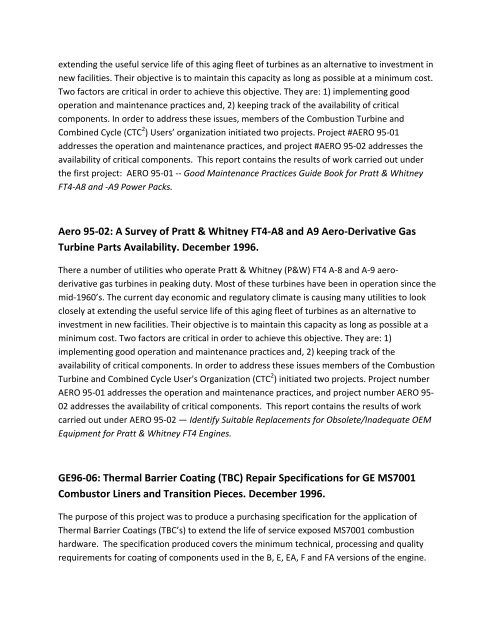GE94-02: Repair Flow Testing and Calibration Procedures for ...
GE94-02: Repair Flow Testing and Calibration Procedures for ...
GE94-02: Repair Flow Testing and Calibration Procedures for ...
You also want an ePaper? Increase the reach of your titles
YUMPU automatically turns print PDFs into web optimized ePapers that Google loves.
extending the useful service life of this aging fleet of turbines as an alternative to investment in<br />
new facilities. Their objective is to maintain this capacity as long as possible at a minimum cost.<br />
Two factors are critical in order to achieve this objective. They are: 1) implementing good<br />
operation <strong>and</strong> maintenance practices <strong>and</strong>, 2) keeping track of the availability of critical<br />
components. In order to address these issues, members of the Combustion Turbine <strong>and</strong><br />
Combined Cycle (CTC 2 ) Users’ organization initiated two projects. Project #AERO 95‐01<br />
addresses the operation <strong>and</strong> maintenance practices, <strong>and</strong> project #AERO 95‐<strong>02</strong> addresses the<br />
availability of critical components. This report contains the results of work carried out under<br />
the first project: AERO 95‐01 ‐‐ Good Maintenance Practices Guide Book <strong>for</strong> Pratt & Whitney<br />
FT4‐A8 <strong>and</strong> ‐A9 Power Packs.<br />
Aero 95‐<strong>02</strong>: A Survey of Pratt & Whitney FT4‐A8 <strong>and</strong> A9 Aero‐Derivative Gas<br />
Turbine Parts Availability. December 1996.<br />
There a number of utilities who operate Pratt & Whitney (P&W) FT4 A‐8 <strong>and</strong> A‐9 aero‐<br />
derivative gas turbines in peaking duty. Most of these turbines have been in operation since the<br />
mid‐1960’s. The current day economic <strong>and</strong> regulatory climate is causing many utilities to look<br />
closely at extending the useful service life of this aging fleet of turbines as an alternative to<br />
investment in new facilities. Their objective is to maintain this capacity as long as possible at a<br />
minimum cost. Two factors are critical in order to achieve this objective. They are: 1)<br />
implementing good operation <strong>and</strong> maintenance practices <strong>and</strong>, 2) keeping track of the<br />
availability of critical components. In order to address these issues members of the Combustion<br />
Turbine <strong>and</strong> Combined Cycle User's Organization (CTC 2 ) initiated two projects. Project number<br />
AERO 95‐01 addresses the operation <strong>and</strong> maintenance practices, <strong>and</strong> project number AERO 95‐<br />
<strong>02</strong> addresses the availability of critical components. This report contains the results of work<br />
carried out under AERO 95‐<strong>02</strong> — Identify Suitable Replacements <strong>for</strong> Obsolete/Inadequate OEM<br />
Equipment <strong>for</strong> Pratt & Whitney FT4 Engines.<br />
GE96‐06: Thermal Barrier Coating (TBC) <strong>Repair</strong> Specifications <strong>for</strong> GE MS7001<br />
Combustor Liners <strong>and</strong> Transition Pieces. December 1996.<br />
The purpose of this project was to produce a purchasing specification <strong>for</strong> the application of<br />
Thermal Barrier Coatings (TBC’s) to extend the life of service exposed MS7001 combustion<br />
hardware. The specification produced covers the minimum technical, processing <strong>and</strong> quality<br />
requirements <strong>for</strong> coating of components used in the B, E, EA, F <strong>and</strong> FA versions of the engine.


